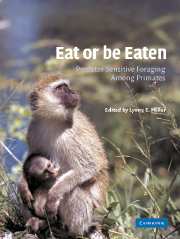Book contents
- Frontmatter
- Contents
- List of contributors
- Preface
- 1 An introduction to predator sensitive foraging
- PART I BIOLOGICAL VARIABLES
- 2 Dangers in the dark: Are some nocturnal primates afraid of the dark?
- 3 Predation sensitive foraging in captive tamarins
- 4 Seeing red: Consequence of individual differences in color vision in callitrichid primates
- 5 Predator sensitive foraging in Thomas langurs
- PART II SOCIAL VARIABLES
- PART III ENVIRONMENTAL VARIABLES
- Index
5 - Predator sensitive foraging in Thomas langurs
Published online by Cambridge University Press: 10 November 2009
- Frontmatter
- Contents
- List of contributors
- Preface
- 1 An introduction to predator sensitive foraging
- PART I BIOLOGICAL VARIABLES
- 2 Dangers in the dark: Are some nocturnal primates afraid of the dark?
- 3 Predation sensitive foraging in captive tamarins
- 4 Seeing red: Consequence of individual differences in color vision in callitrichid primates
- 5 Predator sensitive foraging in Thomas langurs
- PART II SOCIAL VARIABLES
- PART III ENVIRONMENTAL VARIABLES
- Index
Summary
Introduction
The behavior of primates results from a compromise of requirements and risks. The requirements include the acquisition of food and mates and the risks include predators and dangerous conspecifics. Both the acquisition of food and the risk of predation will affect behavior on a daily basis. Food, however, may be found on potentially dangerous locations and foraging behavior may be influenced by strategies to reduce predation risk. This paper examines whether this is found for Thomas langurs (Presbytis thomasi).
Many diurnal primates live in groups to reduce the risk of predation (Alexander 1974; Janson and Goldsmith 1995; van Schaik 1983). Individuals in these groups may benefit from group members in several ways: the early detection of predators, alarm calls, confusion of the predator, the selfish herd effect and by joint mobbing and dislodging of the predator (Alcock 1998). A larger group size or more neighbors (Treves 1998) may provide better protection. Not all group members, however, may benefit equally and high-ranking individuals may occupy safer places within the group than low-ranking ones (e.g., Janson 1990a,b; van Schaik and van Noordwijk 1988).
Langur species are largely arboreal primates that are confined to Asia. Their predators include snakes, felids and canids. Snakes and the smaller felids can be found at all heights in the forest, but are probably less agile in trees than primates (e.g., leopards (Panthera leo): Muckenhirn 1972; personal observation of encounters of primates with reticulated pythons (Python reticularis) and a clouded leopard (Neofelis nebulosa)), whereas the tiger (Panthera tigris) and canids (jackals (Canis aureus): Stanford 1991; domestic dogs (Canis domesticus): Sommer 1985) are confined to the ground.
- Type
- Chapter
- Information
- Eat or be EatenPredator Sensitive Foraging Among Primates, pp. 74 - 92Publisher: Cambridge University PressPrint publication year: 2002
- 5
- Cited by



